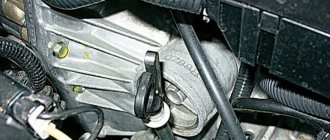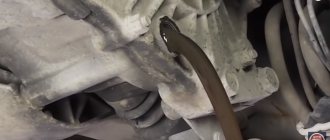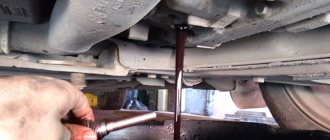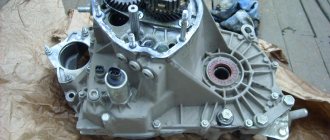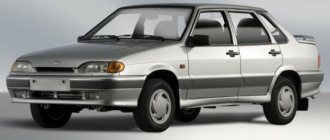When choosing which oil to pour into an automatic transmission, you need to consider a number of factors. Firstly, it differs in many ways from manual transmission oil, since there are features unique to ATF (Automatic Transmission Fluids). For example, participation in the transmission of power from the internal combustion engine to the wheels in the torque converter of an automatic transmission and control of its modes.
In addition, if the car has friction blocks, the oil must constantly provide high-quality friction when the friction clutches come into contact. That is, it should simultaneously reduce the coefficient of friction in loaded units and increase friction in the friction discs.
It turns out that ATP is subject to mutually exclusive requirements, and requires a very sensitive approach to the choice of additives.
Decoding the markings of transmission oils for automatic transmissions
One of the main indicators that you need to look at when choosing oil for an automatic transmission is its viscosity. It directly affects the ability of the composition to continuously lubricate the entire surface of the parts. With the correct oil viscosity, the transmission can operate smoothly at low temperatures. Its efficiency increases and hydraulic losses decrease.
The viscosity of lubricant for automatic transmissions is determined according to the SAE J 300 DEC 95 classification. It is measured in numbers and can take values from 4.1 to 41. Depending on the viscosity, the oil is divided into classes. When choosing, they are guided by the operating conditions of the vehicle and climatic conditions.
Winter classes are designated from 70W to 85W in increments of 5 units. The "W" stands for "winter." The lower the number, the more resistant the oil is to temperature changes.
For example, for 70W the lowest temperature is -50 degrees, and for 75W it is already -40 degrees. Summer oils are simply indicated by numbers. They start at 80 and end at 250. There are also multi-grade oils, such as SAE 80W-90.
API characteristics indicate the quality of the oil’s performance of its tasks:
- API GL-1…5. Indicates the quality of the oil. With number 1, the lubricant is capable of performing the simplest tasks; class 5 is characterized by work under higher loads.
- MT-1 API. This is a new category, identical to API GL-5, but with greater heat resistance.
These properties of oils determine their ability to work in various conditions.
What is ATF fluid?
ATF fluid is a special transmission oil that has a liquid consistency and has a mineral or synthetic base. It is intended for cars running on automatic transmission. ATF transmission fluid is responsible for performing many functions, for example:
- uninterrupted operation of the gearbox - its monitoring and control;
- cooling and proper lubrication of parts that are subject to friction;
- transmission of torque, which passes from the engine to the gearbox through a torque converter;
- ensuring the operation of friction discs.
Many people equate oil with an automatic transmission mixture, but the properties of ATF differ in many respects. To obtain the correct composition, mineral oils are used, to which special substances are added. If you use foreign fluids for “automation”, this will most likely cause a breakdown of the gearbox, or its complete failure.
In addition to the manufacturers themselves, who produce technical fluids under their own name, there are “universal” ATF fluids on the market.
The manufacturer of the first oil specification was the automobile concern General Motors. The new mixture entered the mass market in 1949. This was due to the fact that in 1938 the same company developed the first automatic transmission. Subsequently, the automaker began to work closely on improving the specifications of transmission mixtures and established the strictest requirements for the composition. Since there were no competitors in this market, GM became the setter of technical specifications for ATF.
The first types of liquid were made from fat, which was produced from the fat of sea whales. Due to the passage of a law prohibiting hunting of these ocean inhabitants, the corporation had to develop a synthetic base.
At the moment, other famous car brands - Chrysler, Hyundai, Mitsubishi Ford and Toyota - compete with the specifications from General Motors.
Pay special attention to the packaging of the ATF fluid you purchase. Consider the type of oil as well as the specification that suits your transmission.
Characteristics of transmission oil for automatic transmission
Like engine fluids, transmission fluids can be synthetic and semi-synthetic, original, recommended by the automatic transmission manufacturer, as well as universal. Synthetic ones initially have excellent quality, retain their properties at both high and low temperatures and have a longer service life.
Their use is permitted in almost all automatic transmissions (older cars may be an exception). Semi-synthetics are more affordable, but in a number of indicators they are inferior to synthetics.
Composition of ATF oils for automatic transmissions
Since the properties of ATF are very diverse, manufacturers often hide their composition. The liquid is very complex. Only a general idea can be obtained about the molecular composition of lubricants for automatic transmissions.
In terms of its chemical composition, car transmission oil consists of a base and a package of additives.
The basis, as already mentioned, can be of several types:
- synthetic;
- mineral;
- semi-synthetic.
Petroleum and paraffin oils are used as a mineral base. Semi-synthetics are represented by hydrated mineral-based compounds. Polyalphaolefin oils are truly synthetic. They are produced using complex and expensive technology.
In addition to the base, up to 15% of the composition is occupied by additives:
- preventing the formation of foam;
- anti-wear;
- corrosion inhibitors;
- friction modifiers;
- antioxidant;
- dispersants that hold wear products in suspension.
This fluid composition ensures proper operation of the automatic transmission for a long time.
Original oils for automatic transmissions
Original oil is the one that is strongly recommended or produced by the car manufacturer itself. Such oils are used by official services; ATF is often sold under the brand name of the car manufacturer. The risks of possible machine malfunctions due to the use of unsuitable oil are eliminated, but its price is quite high.
Each manufacturer determines its own labeling and composition tolerances for the machine. These requirements are almost identical to each other. Most famous endorsements:
- GM (DEXTRON II, III, IV),
- Mitsubishi-Hyundai-Kia (SP-II, III, IV, Red-1),
- Toyota (T, T-III, IV, WS).
In addition, the automatic transmission manufacturer itself can provide information about which analogues can be used in a particular gearbox. For example, for different gearboxes Aisin, Jatco, and so on, you can separately indicate tolerances and recommendations for oil, as well as suitable ATF options, that is, there is a choice. At the same time, the price of analogues is cheaper than the original.
Car manufacturers themselves do not produce transmission oils. This is done by companies that produce universal formulations. Often the branded canister contains the same non-original liquid, only at an inflated price.
Universal gear oils
Universal ATFs have a maximum additive package, which allows them to work in various types of automatic transmissions. They are beneficial, but the risks of automatic transmission failures cannot be completely eliminated.
These ATFs meet the approvals of several manufacturers at the same time and are suitable for different models.
It is much easier to select a universal analogue of the original ATF oil for European cars. This is due to European antitrust laws. It is more difficult to find fluids for a Japanese car.
Modern use
Modern ATFs consist of a base oil plus an additive package containing a wide variety of chemical compounds designed to provide the required properties of a particular ATF specification. Most ASSALX contain some combination of additives that improve lubricity, such as anti-wear additives, rust and corrosion inhibitors, detergents, dispersants and surfactants (which protect clean metal surfaces).
Kinematic viscosity and viscosity index improvers and modifiers, swell compaction additives and agents (which expand the rotation speed range and temperature range of application of additives); anti-foam additives and antioxidant compounds to inhibit oxidation and “boil-off” (which extends the life of additives); cold flow improvers, high temperature thickeners, conditioners, gasket curing depressants and petroleum colorant.
All ASSALHI contain friction modifiers, except those specified for transmission fluids other than Ford transmissions and John Deere J-21A specifications; Ford ESP (or EOS) - M2C-33 F type F ATF specification (Ford-O-Matic) and Ford ESP (or EOM) - M2C-33 G type G ATF specification (1980s Ford Europe and Japan) specifically exclude adding friction modifiers.
According to the same oil distributor, the M2C-33 G specification requires fluids that provide increased shear stability and oxidation protection, lower temperature fluidity, better EP (Extreme Pressure) properties and additional seal testing beyond M2C-33 F quality fluids.
There are many specifications for ATF, such as the General Motors (GM) DEXRON and Ford MERCON series, and the vehicle manufacturer will determine the ATF specifications suitable for each vehicle. The vehicle owner's manual will usually list the ATF specifications(s) that are recommended by the manufacturer.
Automatic transmission fluids have many improving chemical additives in the fluid to meet the needs of each transmission. Some ATF specifications are open to competing brands, such as the common DEXRON specification, where different manufacturers use different chemistries to meet the same performance specification. These products are sold under license from the OEM responsible for creating the specification. Some vehicle manufacturers require "genuine" or original equipment manufacturer (OEM) ATF. Most ATF preparations are open to third party licensing and certification by the vehicle manufacturer.
Each manufacturer has specific ATF requirements. Incorrect transmission fluid can cause transmission failure or serious damage.
How much oil to pour into automatic transmission
ATF oils intended for automatic transmissions are included in a separate category of lubricants. They are most often produced in red, but some manufacturers use other colors.
The required amount of oil for an automatic transmission is determined by which replacement option is proposed:
- full or partial,
- hardware replacement using the displacement method or the oil will be changed “by spilling”.
Based on this, you can more accurately understand how much ATF oil may be needed in an automatic transmission.
In most cases, to completely change the oil in an automatic transmission using the “spill” method, at least 10-12 liters of transmission oil are required.
When replacing using the displacement method - more.
For a partial replacement, when the ATF oil is not changed but updated, 4-5 liters are enough.
Important. With such a replacement, it is undesirable to mix different oils in the automatic transmission, especially with different bases.
Purpose and features
Transmission lubricants are conventionally divided into two groups:
- for manual transmissions (gearboxes, transfer cases and other units in which only gearing is implemented and oil does not work to transmit pressure to the control mechanisms);
- for automatic transmissions (their difference from mechanical lubricants is the additional ability to work in control and actuating mechanisms of automation operating under pressure).
ATF transmission oil for automatic transmissions is used not only in traditional gearboxes, in which torque is transmitted through a torque converter to planetary gear sets. ATF fluids are also poured into modern DSG boxes, CVTs, robotic versions of mechanics, power steering and hydraulic suspension systems.
ATP oils have a number of key features that make these lubricants a separate category
- Relatively low viscosity. The average kinematic viscosity at 100°C for ATP lubricants is 6-7 cSt. While transmission oil for a manual transmission with a viscosity of SAE 75W-90 (which is often used in the central zone of the Russian Federation) has a working viscosity from 13.5 to 24 cSt.
- Suitable for use in hydrodynamic transmissions (torque converter and fluid coupling). Conventional lubricants are too viscous and do not have sufficient mobility to flow freely between the pump and turbine wheel blades.
- Ability to tolerate high blood pressure for long periods of time. In the control and executive units of the automatic transmission, the pressure reaches 5 atmospheres.
- Durability of base and additives. It is unacceptable for base oils or additives to degrade and precipitate. This will cause malfunctions in the valve system, pistons and valve body solenoids. Technological ATP fluids can last 8-10 years without replacement.
- Frictional properties in contact patches. Brake bands and clutches operate using friction. Automatic transmission oils contain special additives that help the discs and brake bands to grip reliably and not slip at a certain pressure in the contact patch.
On average, the price of ATF fluids is 2 times higher than that of transmission lubricants for manual transmissions.
Timing for changing transmission oil in automatic transmissions
Oil changes in automatic transmissions are not performed as often as in engines. The manufacturer's recommendations indicate when to change the oil under normal or severe vehicle operating conditions. In the latter case, replacement is carried out almost twice as often.
Severe conditions include:
- dynamic driving – quick start and sharp braking;
- operating the car in urban conditions, which reduces the quality of the oil in the box;
- work in difficult weather conditions - in the cold (below -20) or in the heat (above +35);
- long-term operation of the vehicle at maximum loads;
- regular off-road driving: rocks, snow, gravel.
In old cars, the oil is changed every 30-40, in new cars - 50-60 thousand km.
In a car with an automatic transmission, compared to a manual transmission, the pressure on the plungers is less, so the oil must be thinner.
How to avoid rapid blackening of petroleum products
There is no 100% way to avoid blackening of the grease. However, there are certain rules, compliance with which makes it possible to maximize the service life of the consumable.
- Choose the right oil fluid. If the oil is of low quality, it must be changed.
- The lubricant must have good performance. When choosing a consumable, you need to take into account not only the brand of petroleum product, but also its characteristics. Transmissions from different manufacturers function differently, so the optimal consumables must be selected for each gearbox.
- The vehicle specification must match the transmission specification. It happens that lubricant cannot be poured into any model of car. In this case, you need to read the gearbox specification and choose a different oil.
- Monitor the condition of the automatic gearbox. If the transmission is severely worn, it must be repaired. It may be enough to replace certain parts.
- Wash the unit. Follow the specified flushing intervals. It's quite easy to do. If this procedure is difficult for you, contact a specialized service center.
What kind of oil is needed to fill an automatic transmission?
Let's dive into specifics. What kind of oil does the manufacturer recommend to put in the box and what are its requirements? We will look at the most popular car brands.
Transmission oil for automatic transmissions of American-made cars
Ford is the most popular among American cars. Focus, Fiesta, S-Max models have a unique and unpretentious 4-speed 4F27E. Low viscosity oils, such as Dexron VI or Mercon LV, are poured into automatic transmissions. Low-viscosity fluid heats up faster in winter, which reduces the risk of damage to the automatic transmission clutch.
Since 2008, Ford has partnered with Getrag to develop PowerShift preselective automatic transmissions. The box is installed in Focus, S-Max, Mondeo, Fiesta, Kuga. Automatic transmissions are sensitive to the quality and type of gear oil, so it is better to change it after reaching 50,000 km. Fits well in the box Ford BO-DC art. 1 490 763 1 940.
Chevrolet Aveo, Captiva, Cruze, Epica with 6T40 / 6T45 automatic transmission run on Dexron VI synthetic oil. Shift units are set to operate at the limit, and excessive torque load will quickly lead to transmission failure. Hydraulics are no less demanding on the quality of oil, so it must be changed when it becomes dirty.
The Chrysler 300, Dodge Dakota and Jeep Cherokee 42RLE, 5-45RFE automatics are reliable, without too delicate electronics and will last a long time if not loaded to the limit. They operate on Mopar ATF 4+, Dexron III – VI class fluids.
What kind of oil to pour into the automatic transmission of European-made cars
Among European cars, Volkswagen, Skoda and Renault sell well in Russia. They are mainly equipped with Japanese hydraulic automatic transmissions or German robotic gearboxes.
Thus, the Czech Skoda installs six-speed TF-60SN automatic transmissions on Fabia, Octavia, and Superb. A modification of this box is also available in VW Polo. The automatic transmission is proven, reliable, but sensitive to ATP levels. Original oils for automatic transmissions are T-IV or WS, depending on the design.
The Skoda Kodiaq is only available with DSG-6 or DSG-7. The same robots are found in the Audi A3, Q3, and VW Tiguan. They accelerate quickly, save fuel, but are susceptible to overheating and off-road driving. It is recommended to change the VAG G 052 182 A2 oil every 40-60 thousand km.
All-wheel drive Renault Duster and Kaptur are equipped with a DP8 automatic transmission. The torque converter lock-up developed by ZF is already engaged at first speed. Before a major overhaul, the automatic transmission can travel 200,000 km with careful operation. You can pour Renaultmatic D3 SYN art. 156908 or Dextron 3.
Mercedes Benz models of the CL, CLC, E, G Wagon, SL, Viano classes are very popular in the secondary market. These vehicles are equipped with the 722.6 automatic transmission, which is also found in American Dodges and Jeeps.
The box is repairable and can last forever if you change the oil, filter and consumables on time. 722.6 is filled with synthetic oil A with approval MB 236.14. Although in theory the oil is irreplaceable, in practice after 100,000 km it becomes dirty and the performance of the gearbox deteriorates.
Oil for automatic transmissions of Russian-made cars
Among domestic models, Lada Granta and Lada Vesta are in demand. At the same time, the demand for manual transmissions is higher than for cars with automatic transmissions. Although the Granta has a 4-speed Jatco JF414E - a reliable hydraulic automatic transmission.
The box is undemanding in terms of gear oil, and instead of the original Nissan Matic-S art. 999MP-MTS00P, the automatic transmission perfectly accepts any ATF Dextron 6.
The first Vesta was equipped with an AMT robot specially designed for Lada. At the plant, Tatneft TM-4-12 SAE 75W-85 API type GL-4 was poured “for the entire service life” or 5 years. But experts recommend changing the oil every 75,000 km.
Since 2022, Lada Vesta has been sold with the Jatco JF015E variator. This machine is designed for economical trips around the city. Aggressive driving overloads the belt and bearings of the variator, which leads to their rapid wear.
The automatic transmission is sensitive to cleanliness and lubricant level, so it needs to be changed after 40,000 km. This machine is filled with synthetics for a CVT gearbox of the Nissan NS-3 type, art. KLE53-00004.
What to put in the automatic transmission box of Korean cars
Korean-made cars are mainly equipped with Hyundai-Mitsubishi automatic transmissions running on SP specification oil. Korean automatic transmissions are not demanding on oil, but it is recommended to change it as soon as it loses its transparency. Best-selling automatic Kia and Hyundai models:
Kia Sportage, Sorento, Hyundai Sonata, Santa Fe – modifications F4A51, SP-III semi-synthetic oil, art. 04500-00400, or equivalent Dextron 3.
Kia Ceed, Cerato, Rio, Soul, Hyundai Accent, i20, i30, Solaris – A4СF modifications, semi-synthetic SP-III, art. 04500-00400, or equivalent Dextron 3.
Kia Optima, Rio, Sorento, Sportage, Soul, Hyundai Creta, i30, ix35, Santa Fe, Sonata, Solaris, Tucson – A6LF modifications, synthetic SP-IV, art. 04500-00115.
Kia Mohave, Opirus, Hyundai Equus, Genesis – A8LR1, synthetic SP-IV RR, art. 04500-00117
Transmission oils for automatic transmissions of Japanese cars
Toyota, Nissan and Mitsubishi are popular among Japanese cars. Each manufacturer equips cars with its own automatic transmission. The oil for these automatic transmissions meets each company's standards.
The most popular are Toyota Rav 4 and Camry. These machines are equipped with Aisin U660 boxes. The automatic transmission shifts in less than half a second, saves fuel and operates smoothly, but suffers from rapid wear on the clutch and torque converter. The car runs on Toyota WS synthetics, which can retain its properties at + 130℃.
Nissan prefers to install CVTs in its cars. Qashqai, Tiana, Tiida, X-trail are equipped with the best-selling variator – JF011E. It does not bug, is repairable and, if used correctly, lasts almost forever. But it is picky about the purity of the oil. To increase the resource of the box up to 200,000 km Nissan NS-2 art. KLE5200004EU is recommended to be replaced when dirty.
Mitsubishi's hit is the Outlander, equipped with a JF011E CVT or a JF613E six-speed automatic transmission. This box is also found in Nissan and Renault models. The hydraulic system does not like extreme conditions and overheating.
With quiet driving, major repairs can be postponed up to 200,000 km. Oil change Nissan Matic-S art. 999MP-MTS00P – partial, upon reaching 60-80,000 km.
History of the creation of ATF
The first transmission oil, called ATF-A, was developed by General Motors in 1949.
Before this, motor oils were used in machines, and the operation of the box was extremely difficult and short-lived. With the development of the automotive industry, technologies and standards have changed. In 1967, GM introduced the first standard, Dexron type B. To make it easier to detect leaks, the fluid was colored red.
The next specification was Dexron II. The oil had weak anti-corrosion properties: the metal parts of the automatic transmission quickly rusted. By the 1990s, the lubricant was switched to a synthetic base.
With the advent of ECUs and hydraulic units in automatic machines, the requirements for oil have become more stringent. GM has developed new standards Dexron III, VI. The base has been improved, friction properties have improved, and the package of modifiers has been updated.
General Motors also introduced the Allison C4 specification with requirements for lubricants operating in transmissions of trucks and heavy equipment.
For its boxes, Ford developed the M2C33 specification in 1959. And in the 1980s, the Mercon standard appeared. Oils meeting the requirements of these specifications are similar in their characteristics to Dexron.
Interchangeability of transmission oils
The automatic transmission of 90s cars was created in the late 80s, and no structural changes occurred until 2003. Therefore, new ATF cannot be poured into automatic transmissions of cars from the 90s.
There are certain nuances of replacing modern oils:
Dexron II can be replaced by Dexron III (but not vice versa) if the equipment allows for an increase in modifiers that can reduce friction. This group includes GM boxes.
In cases where the equipment cannot reduce the coefficient of friction by increasing the effectiveness of the additives, Dexron III cannot replace Dexron II.
Regardless of hardware, Dexron IIE replaces Dexron IID, but not vice versa. Replacement is often due to the fact that Dexron IID does not tolerate frost well - it is suitable for use at temperatures not lower than -15. It is worth considering that Dexron IIE is needed only in the northern regions and costs 2-3 times more.
Advantages and disadvantages
Like any metal, material, part or anything else, ATF 2 lubricating fluid from ZIK has its pros and cons.
The lubricant has advantages over its competitors:
- stable during thermal-oxidative processes;
- Compatible well with any seal material;
- at any temperature, especially sub-zero, the gear shifts smoothly, clearly and comfortably;
- the transmission operates silently;
- there are properties - high anti-corrosion;
- when used at low temperatures, fluidity is high;
- The service life of all systems is extended.
If the fluid is used in accordance with all regulations and instructions, the transmission oil in question cannot have any deficiencies.
Is it possible to mix ATF oils from different manufacturers?
When stirring, sediment may appear - white flakes that can clog the transmission. First of all, CVTs and automatic transmissions suffer from this. If the filters become clogged, the system will quickly fail. In some cases, no sludge will form, but the performance of the transmission is at stake.
Important! Mixing synthetics and mineral water will not result in semi-synthetics.
But a lot of foam is formed, which after 500 km thickens and forms precipitation. The oil seal may be squeezed out. If whitish flakes are detected, the system is completely flushed.
Why is ATF so expensive?
Many people are interested in the question: why do universal oils cost drivers more than other products? Indeed, the price can range from 700 to 800 rubles. for one liter. We calculate: the machine absorbs 8-10 liters when refueling. Multiply by the cost and you get an unpleasant amount for the family budget - 8 thousand rubles. We understand that progress does not stand still. Evolution comes at a price. Rice. 5. The product we are considering is more advanced than conventional operating oil. Conclusion: we pay for quality. The cost is also affected by the operating period, which ranges from 60 to 70 thousand kilometers. In addition, this is full-time work in a hazardous environment.
How to find out what kind of oil needs to be poured into an automatic transmission
You can determine the type of transmission oil for an automatic transmission in the following ways:
- Inspect the automatic transmission dipstick - usually the recommended ATF for this car is indicated there;
- Look at the plate under the hood - the ATF type may also be indicated there;
- Study manufacturers' catalogs or contact a service station.
The color of the ATF does not affect anything. It depends only on the dye and is necessary for rapid identification.
And you need to remember that some car manufacturers (for example, Honda and Mitsubishi) strongly recommend using not just any oil in automatic transmissions, but only specialized ones, otherwise the manufacturer cannot guarantee normal operation of the automatic transmission.
Consequences of oil wear
Thus, oil (technical fluid) is a high-tech product with many properties that are achieved through a combination of ultra-expensive additives, and performs many functions.
Depending on the specification of a particular product, ATF can be said to consist of 20-30% additives and 70-80% base oil. Long-term use changes the properties of both. This means that all of the listed properties must be above the minimum critical level throughout the entire service life. If at least one of them gets worse, over time it will pull the rest with it.
The properties of ATF oil change over time - this is a proven and well-known fact. Waste oil shortens the life of the gearbox, ultimately leading to its failure.
For example: if acid neutralization capacity decreases, ultra-precise leading surfaces and seals are the first to suffer. As a result, leaks form in the oil channels of the box and pressure decreases. This in turn leads to increased wear of the clutch discs. Material that separates from the discs due to increased wear reduces the oil filter's capacity, leading to an overall drop in system pressure. The latter, in turn, affects the operation of the box as a whole. Similar examples of effects can be given for other properties, be it foam inhibitors or anti-wear agents.
How to store: safety precautions
It is enough to pay attention to the manufacturer’s recommendations, which indicate the service life, rules and handling features. It should not be stored with gasoline or other flammable substances. As for safety precautions. In this case, it is necessary to work with protective gloves and prevent liquid from getting into your eyes. If this happens, you must rinse your face with running water and seek qualified medical help. The room where the lubricant is stored must be equipped with fire protection and an alarm system.
How to spot a fake
The manufacturing company is constantly improving the protection of its product from counterfeiting. To buy the original ZIC ATF Dexron 2 and not be upset that it is not a fake, you need to know the following:
- The canister has a completely red color and red labels.
- The lid is packed with thermal film with the inscription SK.
- Removing the cover, another protection is immediately visible.
- Transparent measuring scale.
- There is a hologram along the vertical stripe.
- The back label has raised text that can be felt with your fingers.
- The company puts a company stamp on the bottom of the canisters.
- The packaging is not made of uniform plastic, but with different textures.
The most important thing is to purchase fuels and lubricants in official networks and stores.


